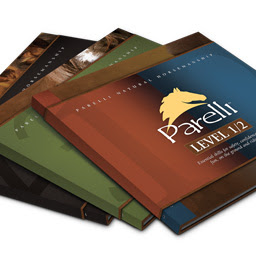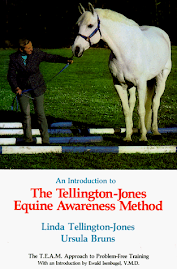Source: Flickr/Robbert Michel/CC.
Republished with permission from the Desert Horse Equestrian Services blog. From Allana:
It all started when I got bucked off my horse . . .
Horses have been my life since childhood. Living on a 160-acre farm in Nebraska, and having a large animal veterinarian for a stepfather, was my perfect world. Lots of horses, open pastures, blue skies and leisurely rides — my own personal heaven on earth. After high school, however, reality set in and with a family, horses were a luxury that couldn’t be afforded for almost 25 years until the last child left the nest. But horse ownership had changed so much in those 25 years. And so had training. Something called “natural horsemanship” was everywhere, touting the notion that anyone could train her own horse to be the perfect partner, if only she attended a clinic, purchased the special equipment, watched the DVDs and believed.
And believe I did, for almost six years. I took lessons, bought or rented DVDs, went to clinics and purchased rope halter, sticks, hackamores, lead ropes. I purchased not one, but two, untrained horses, thinking I could train them myself. But something else had changed in those 25 years too. I had lost my confidence to ride. I wouldn’t call it all-out fear, because I could mount a school horse without hesitation and took riding lessons sporadically for several years, trying to overcome the lack of confidence I had in riding my own horses. Finally, the inevitable happened and after being thrown from my horse, the realization set in: I needed to stop thinking I could train my own green horse via natural horsemanship and get my horse to a professional trainer.
Giving credit where credit is due, natural horsemanship definitely is an improvement over the “breaking” methods of some traditional trainers. The techniques helped me gain confidence on the ground and taught me about horse personalities, reading body language and recognizing warning signs. The methods, even loosely followed, do work. Several trainers have told me that my horse, without a doubt, has the best ground manners of any horse they have ever handled. Because I was able to attain a measure of success, the decision to break away from natural horsemanship was not an easy one. I didn’t know it yet, but it was imperative for me to stop thinking “What would Linda Parelli do?” and start paying attention to what was really going on, for the health of me and my horse.
My farrier/massage therapist started the ball rolling when she asked me to back up my horse during a massage session. In correct natural horsemanship fashion, I stood in front of my horse and wiggled the rope. His head went up, back hollowed, and he slowly stepped backwards. “Can I tell you something?” I nodded. “When you back your horse that way, it causes him to have a sore back.” OMG. That back-up technique is the mainstay of all the natural horsemanship programs I’d studied. OK. So what else was happening behind the scenes?
At left, Mo has his head up, back arched, hind legs splayed. The arrow indicates where the massage therapist and chiropractor found his “trouble spot” over his croup. Because he was out of alignment and tight, his hind legs were not able to come underneath and support his body in balance properly. He needed three adjustments to fix this, plus I needed to STOP backing him up in this way. Right photo shows the new way we back up. Head low, nice relaxed back, and the hind leg is stepping under the body to support his weight in balance. It was not an overnight fix. It took two months of lowering his head and backing up, several steps at a time, as it was so hard for him to change over from what we had been doing for several years. The end result: a clean bill of health from the chiropractor and now Mo can do more things, like canter on the longe line!
A little common-sense thinking led me to some more revelations:
Halter: I had used a skinny rope halter on my horse for three years with the understanding that it was light and soft and felt good for the horse. Nothing could be farther from the truth. I found out by switching to a wide leather halter that my horse didn’t have those great ground manners all the time with the leather halter. He wasn’t light and sensitive. He was really quite rude and pushy in the leather halter. As in bits, the skinnier the diameter, the more severe. Controlling a horse by using severe tack is just asking for a Jeckyll/Hyde relationship, which is what I apparently had unknowingly created. But going back to the leather halter is like trying to cut steak with a spoon! We are still working on that, but I’m hoping to have a better relationship with my horse when we get it figured out.
Slobber straps: I didn’t realize that the slobber straps — pieces of leather with yachting rope reins that attach to the bit — were so heavy until I borrowed a pair from a friend. I couldn’t imagine a horse carrying all that weight dangling from his bit. So that’s why the natural horsemanship students ride with a slack rein. The constant bit contact is artificially created not by pressure/release from the hands, but by pressure from the weight of the reins. Thus, the horse never gets a total release. Another bad-attitude stimulator.
The Stick: This was an easy one to let go. My horse had always been fearful of the big colored stick with the long string. Try as I might, the stick was cumbersome and difficult to handle while longeing. Once I went back to a longeing or driving whip, my cues were more efficient and he was more responsive and paid more attention to lessons. Maybe I was more confident using the smaller, lighter whip. In any event, things were starting to work better on the longe line.
Obedience: Here is where I totally went overboard. I am a sucker for treats and love having my horse fall all over me for a cookie. The type of natural horsemanship I studied and practiced does not advocate this. But they do advocate looking for signs that your horse is ready or not ready to advance in his training. If he isn’t ready, then you don’t push him. Tomorrow is another day. I had a whole six years of tomorrows and at the end of it, I had a very spoiled horse who thought he didn’t have to do something if he didn’t want to. Not all obedience issues are attitude related. Some are pain. Some are fear. But because we humans are tasked with deciphering the difference, we need to keep trying until we discover the problem.
Here is where the natural horsemanship methods really fall short. It is an unspoken understanding in the program I followed that all Level 1 through 4 students should have a horse that has already been saddle trained. This is not made perfectly clear in their marketing materials. Because so many of their followers are novice horse owners working with not-so-broke horses, for safety’s sake the training suggests that you “just get off” if something isn’t feeling right. I like that. I practice that. If the horse gives me the chance to get off before he explodes, I do. The bottom line is: Horse training is not for amateurs and can not be learned from a book or video or clinic given by a professional horse trainer and it is grossly misleading to imply otherwise. There are always exceptions. But many of the natural horsemanship followers I know have green horses they don’t even ride. Their horses are too spoiled because of this “just get off” guideline and they would never seek help from a more traditional trainer because that would be, well, disloyal.
This is the short list, as I’m still in discovery mode. But one thing is certain: I am glad I was able to enjoy a measure of success with the natural horsemanship groundwork. I am also glad I was able to break away and discover the not-so-pleasant reality before my horse was completely unmanageable and/or I got more than a bruised hip from being thrown.
Many thanks to Allana and Desert Horse Equestrian Servicesfor sharing! What do you think, Horse Nation? Leave a comment below or start a discussion on HN’s new forum Equestrians Anonymous.






























































Was an interesting read. Thanks for sharing it!
ReplyDelete